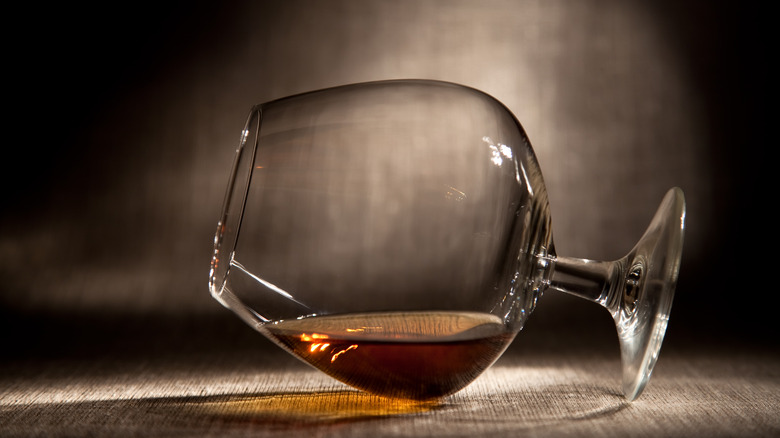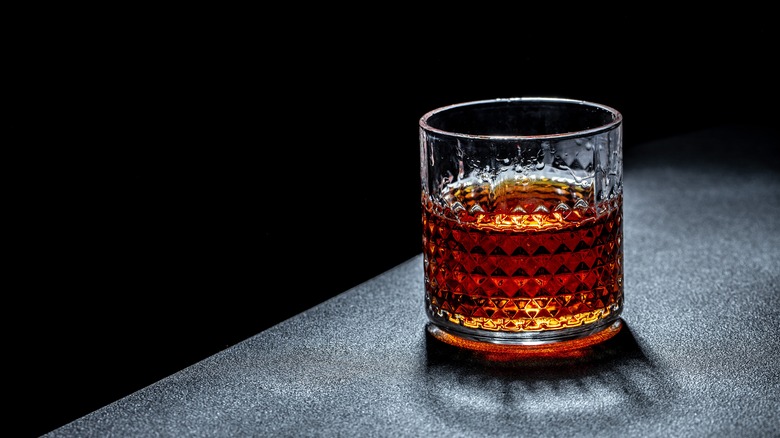What's The Difference Between Cognac And Brandy?
Some alcoholic drinks just feel refined in a way others don't. Of these, it's possible brandy feels the fanciest; drinking it out of a snifter just makes you feel like a 19th-century robber baron expanding his capitalist empire. This entire concept explains why Hennessy is so prevalent in pop culture. But wait, isn't Hennessy a cognac? It is, but it's also a brandy — yet brandy and cognac aren't interchangeable terms.
This may sound confusing, but it's simple once you break it down. The core difference between brandy and cognac is that cognac is classified as a subtype of brandy. It's the old rectangle-square situation, where every square is a rectangle, but not every rectangle is a square. In this case, though, it runs that all cognacs are brandy, but not all brandy is cognac. But once you dig a little deeper, you find that the difference expands from there because the ingredients involved in cognac are distinct from those in other types of brandy — namely, the grapes.
There are all sorts of types of brandy
Brandy is an old liquor, old enough that its name comes from Middle Dutch (which held sway from around 1200-1500), where it was brantwijn. This changed to brandewijn in modern Dutch, but both mean the same thing: burnt wine. In English, this was translated as brandywine before eventually becoming brandy as we know it today.
Brandy itself is a spirit made from distilling wine. Typically, wine is fermented from fruit (usually grapes), where yeast is used to convert the naturally occurring sugar in the fruit into alcohol. Spirits, meanwhile, are made through distillation (this is how spirits and liqueurs are different), which uses heat and the principles of evaporation and condensation to create alcohol. Brandy happens when you expose the distillation process to finished wine and thus winds up way more potent, at anywhere from 35% ABV to 60% – roughly triple that of wine.
As such, brandy can be made using all kinds of fruit, and there are tons of different types of brandy in the world: Slivovitz (Eastern European plum brandy), Calvados (French apple brandy), Pisco (South American grape brandy), and all sorts of other varieties. Cognac is one of these.
Cognac is a very specific type of brandy
If you have a map of France, you can probably guess exactly where cognac comes from: The Cognac region, located near the country's western coast. Cognac has to be made in Cognac, using grapes from Cognac (Monfils, Ugni Blanc, Colombard, Folignan, and Folle Blanche) and aged in French barrels. You know the running joke, "If it doesn't come from the Champagne region of France, it's just sparkling wine?" That same principle applies to cognac, too.
Cognac also has some taste characteristics that set it apart from other types of brandy. It's typically aged in older casks, so the wood doesn't impact the flavor much. Though it's made of grapes, it can be flavored with other types of fruit, leading to all sorts of mixed notes like citrus, stone fruit, or floral flavors. However, as long as it comes from Cognac and follows the rules for cognac, all of these varieties are still cognac. Unlike a lot of brandy, it's not sweetened and generally clocks in on the lower end of the brandy range at around 40% ABV.
So now you'll know the difference for the next time you enjoy brandy. Just don't call it cognac unless it's specifically cognac from Cognac.


